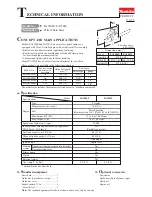
5
Motor Specifications and Electrical Requirements
Motor Safety Protection
Important:
To avoid motor damage, this motor should be
blown out or vacuumed frequently to keep dust from
interfering with normal motor ventilation.
1. Connect this tool to a power source with the
appropriate voltage for your model and a 20-amp
branch circuit with wrong size fuse can damage the
motor.
2. If the motor won’t start, release the trigger switch
immediately.
Unplug The Tool
. Check the saw blade
to make sure it turns freely. If the blade is free, try to
start the “Motor Trouble-Shooting Chart.”
3. If the motor suddenly stalls while cutting, release the
trigger switch, unplug the tool, and free the blade from
the workpiece. The motor may now be restarted and
the cut finished.
4. Fuses may “blow” or circuit breakers may trip
frequently if:
a:
Motor is Overloaded
-Overloading can occur if you
feed too rapidly or make too many start/stops in a
short time.
b: Line voltages should not be more than 10% above
or below the nameplate voltage. For heavy loads,
however, the voltage at motor terminals must equal
the voltage specified for your model.
c: Improper or dull saw blade are used.
5. Most motor troubles may be traced to loose or
incorrect connections, overload, low voltage (such as
small size wire in the supply circuit) or to overly long
supply circuit wire. Always check the connections, the
load and the supply circuit whenever motor doesn’t
work well. Check wire sizes and length with the Wire
Size Chart below.
Wire Sizes
Note:
Make sure the proper extension cord is used and is
in good condition.
The use of any extension cord will cause loss of power. To
keep this to a minimum and prevent overheating and motor
burnout, use the table below to deter-mine the minimum
wire size A.W.G. extension cord.
EXTENSION CORDS
Use only 3-wire extension cords that have 3-prong
grounding plugs and 3-pole receptacles that accept the
tool’s plug. When using a power tool at a considerable
distance from the power source, use an extension cord
heavy enough to carry the current that the tool will draw. An
undersized extension cord will cause a drop in line voltage,
resulting in a loss of power and causing the motor to
overheat. Use the chart provided below to determine the
minimum wire size required in an extension cord. Only
round jacketed cords listed by Underwriter’s Laboratories
(TUV) should be used.
Extension Cord
Length
Wire Sizes Required
220-240V
110V
0-7.5 m
7.5-15 m
Over 15 m
1.5 mm
2
2.0 mm
2
NOT RECOMMENDED
3.0 mm
2
3.5 mm
2
NOT
RECOMMENDED


































